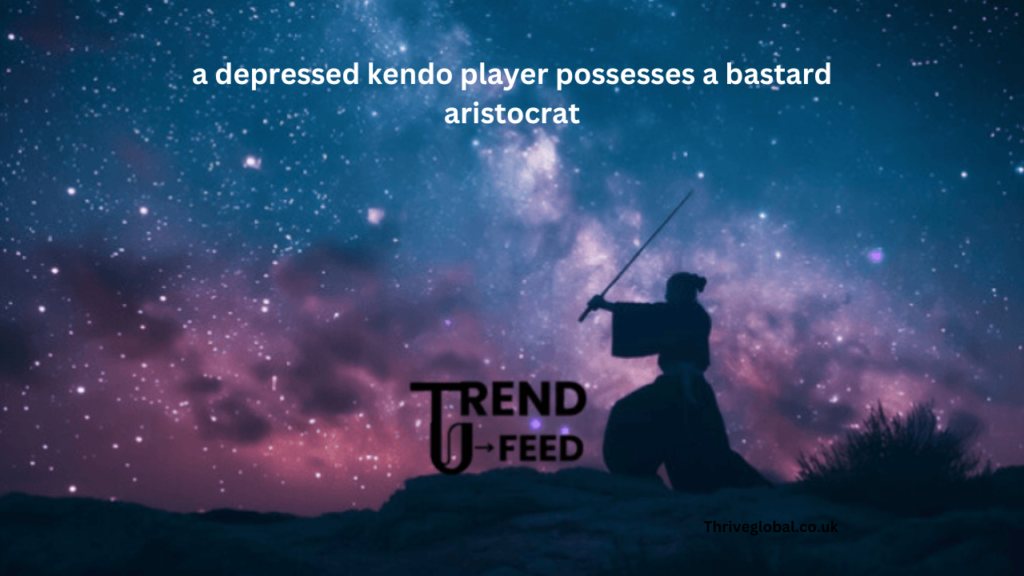Contrasting themes and elements, when combined in the world of storytelling, often produce very interesting and intricately woven works. For this, there’s a great example: “a depressed kendo player possesses a bastard aristocrat,” containing themes of martial arts, mental illness, social hierarchy, and supernatural possession. Here are some potential storylines, character relationships, and symbolism through this combination.
Understanding the Concept
The phrase “a depressed kendo player possesses a bastard aristocrat” employs several different elements:
Depressed Kendo Player: It wouldn’t really matter that the character is a kendo practitioner, which means an exercise of discipline and martial skills and also connection to Japanese culture; however, there is depression afflicting the character. A psychological battle may stem from personal loss or the feeling of purposelessness or because of the expectations one should fill in.
Possesses
Here, the verb “possesses” implies supernatural or metaphysical happening in that the spirit or consciousness of the kendo player possessed someone else’s body. This leads to a development in which the character lives life through the existence of someone else.
Bastard Aristocrat:
Here, the aristocrat is a “bastard,” so it means he is noble blood, but born out of wedlock. The character likely carries social stigma and issues of legitimacy. His background is peppered with the social struggle and tension that creates complication in the dynamics of possession.
This all brings together a narrative that not only is unusual but also rich in the potential for exploring themes such as identity, social class, and personal redemption.
Possible Storyline: A Novel Approach to Redemption
Using the concept of this narrative “a depressed kendo player owns a bastard aristocrat,” a possible storyline could include the following plot events:
Prologue: The Kendo Player’s Struggle
The story opens with the kendo player, one time promising martialist who abandoned because of despair. Perhaps the kendo player was the national champion of this sport, then an idol to many, but after some personal tragedy or just found his shoulders too heavy with the burden of expectations, fell into despair. The passion for kendo is lost, and the kendo player becomes an empty shell of himself.
The Event: Possession and Awakening
In a moment of crisis—near death or an accident—the spirit of the kendo player somehow leaves his body and, to his amazement, ends up in the body of a young nobleman. The young nobleman is a “bastard,” that is, born of noble lineage but with no social acceptance due to the circumstances of birth. Now, the kendo player finds himself inhabiting a body whose set of challenges is completely different.
Life of the New Reluctant Aristocrat
The struggles of the aristocrat continue uniquely when the kendo player struggles to get used to the new way of life, which entails the family’s non-acceptance, societal judgment, and pressure to live up to the dignity of the aristocratic lifestyle. The martial skills that characterize the kendo player resurface and allow them to use kendo in unconventional methods to settle disputes or improve new life situations.
Internal Conflict: Fighting Personal Monsters
The possession does not heal the depression that the kendo player suffers with. They continue fighting inner demons by living out the life of the aristocrat. In meeting other characters and working through problems from the aristocrat’s family, the kendo player slowly begins to find where his own sadness originates. His is a way to healing much like the aristocrat’s was a way to acceptance.
Climax: Redemption and Acceptance
The turning point occurs when both the kendo player and the aristocrat understand that they have to cope with issues of their own past. With this, the former starts getting into the state of emotional healing, while the latter’s life starts to undergo alterations, which will eventually bring a sense of redemption to the character. Perhaps the greatest finale could come to this story: a duel or public challenge where both the kendo player’s skill at his martial arts as well as the newfound strength he has should be tested.
Resolution: The Return or Integration
At the end, the kendo may be able to return his body to normal, with the lessons that he learned while living as the aristocrat following him. Or else, the possession may turn permanent and the kendo now embracing the identity of the aristocrat who’s no longer bothered by depression but rather revitalized.
Themes and Symbolism
The setting, “a depressed kendo player has a bastard aristocrat, affords opportunities for the themes to be developed above:
Identity and Self-Discovery
The plot by its very nature propels an investigation into identity, asking what defines a kendo player-perhaps it is through past experiences, perhaps through his current struggles, or perhaps through this new life as an aristocrat. It engages how, through external and internal circumstances, someone’s self changes.
Her aristocratic background represents social structures, legitimacy, and acceptance. Thus, the kendo player’s struggle to be accepted by society parallels her own fight for self-acceptance.
Mental Health and Healing
Depression is shown in this movie as a never-ending fight that demands introspection and facing personal demons. The kendo player’s journey may represent the process of gaining strength and meaning amidst despair.
Redemption through Martial Arts
This application of kendo as a character development feature provides the story with a cultural depth. The martial arts’ disciplined aspect will be able to serve an image of a battle within the mind of the protagonist in showing ‘mind over matter’ and perseverance amidst the struggle.
Character Analysis
The Depressed Kendo Player
The kendo player, in that case, personifies a guy who has lost his purpose in life. Depression comes to him when he cannot forget one or some incidents that majorly made him emotionally numb. Hence, the message of his journey would not only be finding a new life but reconciling back to the past along with seeking out the passion again that led him.
The Bastard Aristocrat
On the other hand, the aristocrat is a character who has always lived on the fringes of nobility. Their struggle with identity is cogged with social acceptance and legitimacy. Possession brings about the potential for being able to deal with these issues utilizing the kendo player’s martial skills and life experiences to enable personal growth and acceptance.
The Symbolic Role of Kendo
The kendo in the story is greater than a practical martial art-it symbolizes fighting battles in life. Those principles that pertain to kendo-in that they involve focus, precision, and toughness-also seem to be a fight within battling depression. Through practice in kendo, the inner peace of the protagonist can be granted and, therefore, their sense of purpose in life.
Every strike with the shinai could symbolize a breakthrough from self-doubt and depression.
Venturing into the Supernatural Element
The theme of possession gives a different supernatural twist to the plot, which would be necessary to explore metaphysical themes regarding destiny, the soul journey, and chances of second life. This vehicle would also enable the protagonist to look outside of themselves and change one’s view on life in such a way as to gain catharsis and renewal.
FAQs about “A Depressed Kendo Player Possesses a Bastard Aristocrat”
1. What is the story of “A Depressed Kendo Player Possesses a Bastard Aristocrat” for?
The story revolves around a depressed kendo player who, through some supernatural incident, takes on the body of a young bastard aristocrat. The plot runs with his struggle in this new life, facing personal and social issues, and his quest for redemption through all that he encounters.
2. How does the possession transform the characterization of kendo player?
Possession forces the kendo player to face new challenges and lives as an aristocrat; he, however, emerges from the misery in which he is left stranded and emotionally heals and rediscovers his passion for kendo.
3. Why was kendo important in this story?
In this story, kendo is becoming a kind of fight between the hero and his consciousness, a level of self-character identification that sets the ground for internal growing and development. The philosophy of kendo, as well as its discipline, will serve as a metaphor to break the inner barriers and try to find balance in life.
4. “A Depressed Kendo Player Possesses a Bastard Aristocrat”: What themes within this story are you exploring?
Identity and self-discovery, social approval, mental health, redemption, and the interface between traditional martial arts skills and modern problems.
5. In what way, then, does the story address the theme of social status?
The class position of the aristocrat as a “bastard” underscores some of the challenges that come along with social status and legitimacy. The possession enables the kendo player to go through firsthand all these difficulties, touching on issues of identity and acceptance from a different angle.
6. At the end, has the kendo player regained his original body?
The conclusion could even be different based on the direction of the narration. Some may end up getting their original bodies, returning with new knowledge and a fresh purpose in life. Others might end being fully vested in aristocrat life as a new identity.
7. How does the story deal with the theme of mental health?
The story tackles mental health because depression makes up the major conflict in the life of the kendo player. Their travels revolve around a resolve to deal with their emotional turmoil, find ways to heal, and ultimately overcome these inner demons.
8. How does the aristocrat’s background fit into the narrative of the story?
Being a “bastard” is the aristocrat’s background and brings social tension and personal struggles with it, which he must endure as the kendo player in possession of that body. This gives the story a deeper meaning to explore about acceptance by society and legitimacy.
9. What lessons could be gathered from “A Depressed Kendo Player Possesses a Bastard Aristocrat”?
Readers will get to know how depression affects one, how a person should live with themselves, and to what extent confronting fears is a good thing. That said, the novel shows the reader where such purpose may be found in the most unlikely of places and what makes resilience such a powerful force of transformation.
10. Why does supernatural possession appear as a mode of narrative device?
Supernatural possession is a unique narrative tool that allows a story to explore complex themes such as identity, fate, and redemption. It provides a way for the protagonist to leave their usual perspective and grow as they would through experiences in another lifetime.
Conclusion
An interesting and unlikely premise, “a depressed kendo player possesses a bastard aristocrat. Leads the reader to entertain a blend of martial arts, mental health, social struggles, and supernatural elements where the contents weave and try to characterize deep and deeper elements on identity, redemption, and pursuit of inner peace. It is not only an entertaining story but also the strong symbol of redemption against life.



